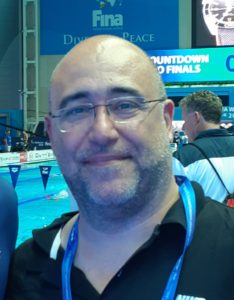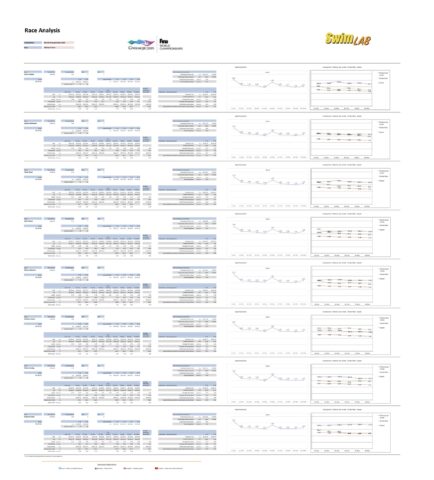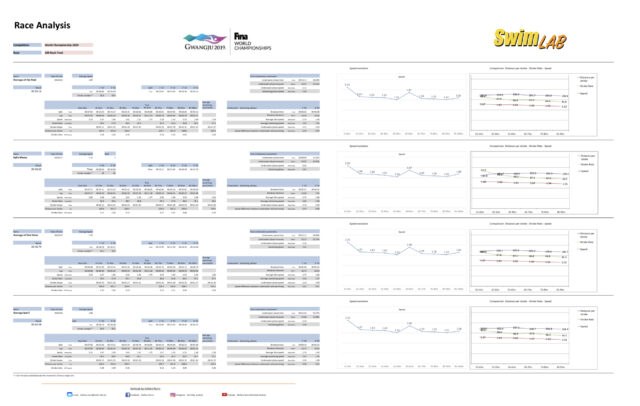Our analysis on the 2019 World Championships finals will tackle the women’s 100m backstroke final today.
It is time to study (but in a fun way)!
- To see a discussion of the information in these analyses, click here.
- Here for the analysis of the final of men’s 100 backstroke
- Click here for the analysis of the final of men’s 100m free
- Here for the analysis of the final of women’s 100m free
WOMEN 100M BACKSTROKE – FINAL
- Daria Vaskina (RUS) 59.74 – 8th place
- Kaylee McKeown (AUS) 59.10 – 5th place
- Taylor Ruck (CAN) 58.96 – 4th place
- Kylie Masse (CAN) 58.60 – 1st place
- Minna Atherton (AUS) 58.85 – 2nd place
- Kathleen Baker (USA) 59.56 – 6th place
- Olivia Smoliga (USA) 58.91 – 3rd place
- Sakai Natsumi (JPN) – 59.56 – 6th place
Race Video (only highlights have been published for public use):
100 backstroke women, what a balanced race!
The main data we can see from the analysis of 100 Backstroke women is that the gap between the first and the last athlete is very small, just 1.14 sec.
The smallest gap in all the analysis I have done so far.
For sure we are speaking about some tiny differences in the race management.
AVERAGE TIME
The average time of the final of the first 50meters is 28.66sec the second one is 30.50sec.
If we check the same parameters of the first three and last five athletes, we can see:
- 28.58sec 1° 50meters and 30.21sec 2° 50meters for the first three
- 28.70sec 1° 50meters and 30.68sec 2° 50meters.
So, the main gap is in the second 50meters. 0.12sec is the gap of the first 50m between first three and last five and 0.47 of the second one.
At 25m the gap is just 0.07sec in favour of the first three swimmers. It is interesting to observe the Kylie Masse swam the first 50m in 28.56, so close to the average time of the final, and the second one in 30.04, faster than everyone.
TURN TIME
To see the first remarkable difference, we need to consider the turn time, from 45m to 65m.
- 11.18sec for the first three
- 11.42sec for the last five.
A more detailed analysis shows us that the time from 45m to 50m is almost the same, so the main difference is from 50m to 65m: 7.90 for the first three and 8.11 for the last five.
Underwater phase
If we also check the underwater phase after the turn, we can see that the first three are faster than last five: 2.08 meter per second vs 1.98 meter per second.
As regards the length of the underwater phase after the turn we have 10.43 meters for the first three and 10.16 meters for the last five.
You may think that the length and the speed of the underwater phase are the only important parameters at first 15m, but if we check the measure and the speed after the start, we can notice that the first three (2.24m/s) are a bit faster than last five (2.20m/s) but the measure in meter is shorter, 12.72m first three and 13.72m last five.
This is a good example to understand the importance of the breakout evaluation.
STROKE RATE
Regarding the stroke rate and distance per stroke we cannot see the same trend we have already seen in the others race analysis (100m freestyle men and women and 100 backstroke men). In this case the average parameters between the first three and the last five are almost the same: 47.5 SR and 202.1 DPS for the first three and 47.2 SR and 202.4 DPS for the last five.
In this race the focus is on the turn and on the second 50m, above all from 85m to 95m where the last five are slowing down the stroke rate a bit. Even the last 5m are important, 0.10 sec difference.
In this race we learned that minor details matter! Thanks girls for showing us!
This story comes courtesy of STEFANO NURRA
- Analyst of Turkish Swimming Federation
- Analyst of Energy Standard
- Owner of Swimlab



How the landscape has changed in 2 yrs!
Biggest take away from this race… Regan Smith wasn’t in it.
Was going to say, there’s an elephant in the room here
Great article though
“Learnt”